FUE hair transplantation
FUE hair transplantation
is a proven, minimally invasive method in which hair follicles are taken from your donor area (back and sides) and then implanted into balding areas.
Special offer – all FUE hair transplants at £1.20 / graft.
What does the procedure look like?
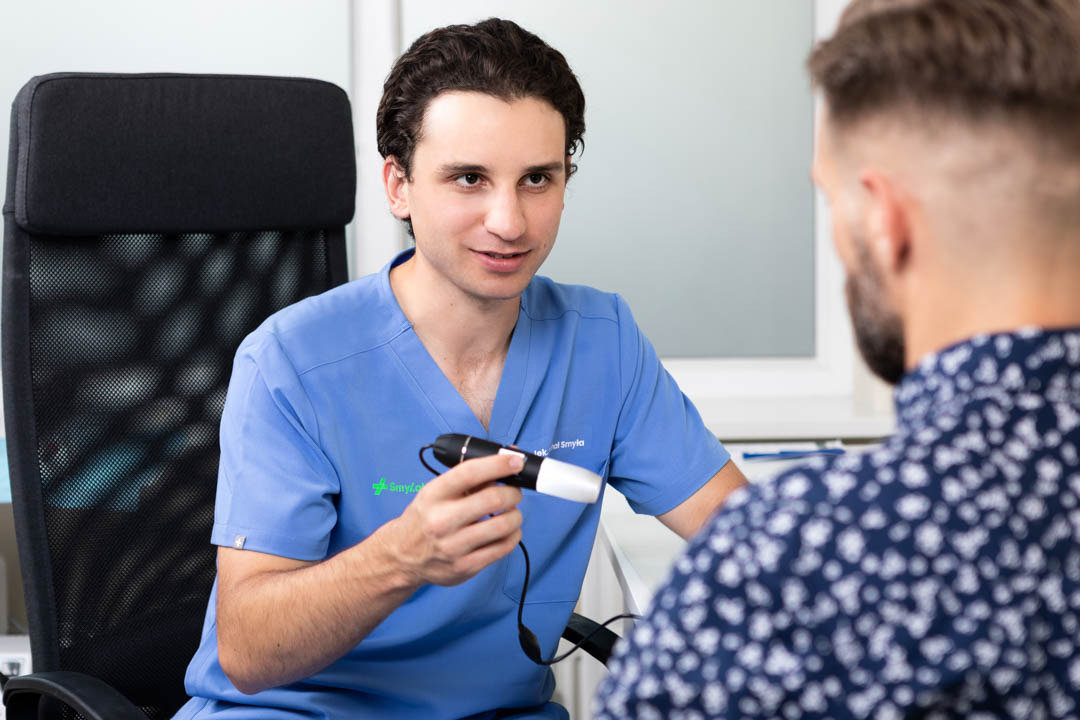
1. Consultation
Before the procedure, we will help you choose the optimal hairline and determine the safe amount of follicles to be transplanted.
The consultation includes:
- preoperative interview,
- videodermatoscopic examination,
- determination of the safe donation area,
- drawing your new hairline.
2. Anesthesia
The procedure begins with the administration of anesthesia to the donor and recipient area.
FUE hair transplantation is:
- performed entirely under local anesthesia,
- virtually painless.
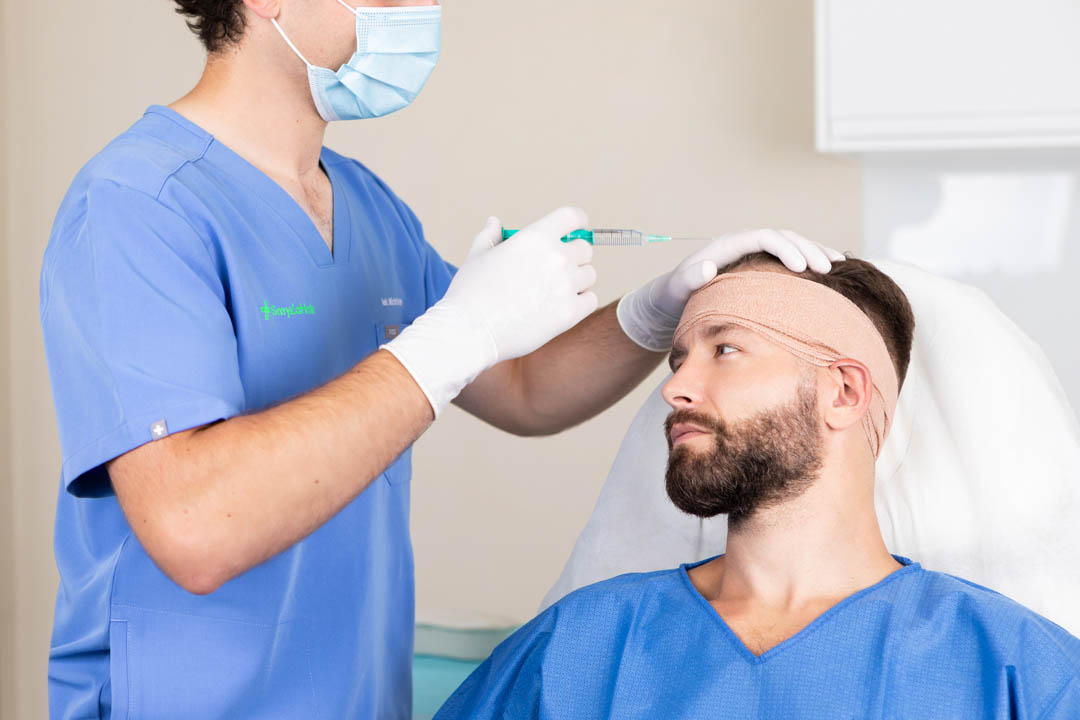
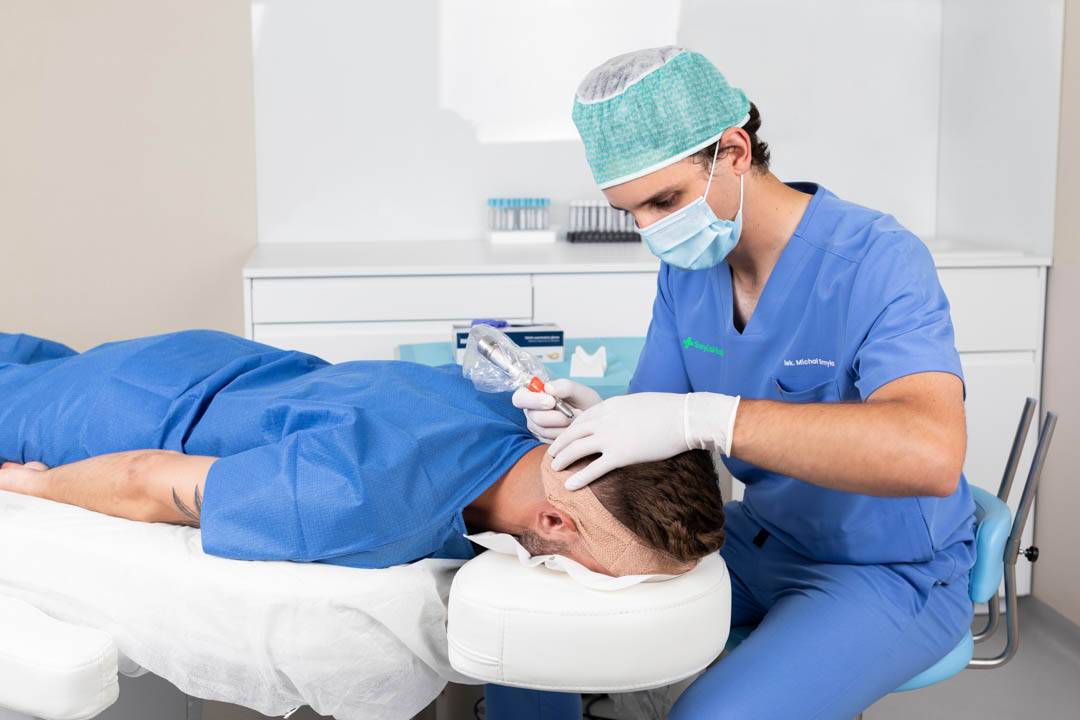
3. Follicle harvesting
The next step is the harvesting of follicles:
- They are harvested using small-diameter, trumpet-shaped punches (0.7-0.9 mm).
This makes the donor sites almost invisible about a week after the procedure, - are taken only from a pre-marked safe donor area.
The rest of the team prepares the follicles for implantation:
- assesses and sorts them based on thickness and hair count,
- transfers them to a holding solution and cools them.
4. Recipient site creation
We prepare incisions for the frontal part of the hairline where the single-hair follicles will go.
This stage is particularly important for us in order to create a natural, aesthetically pleasing look.
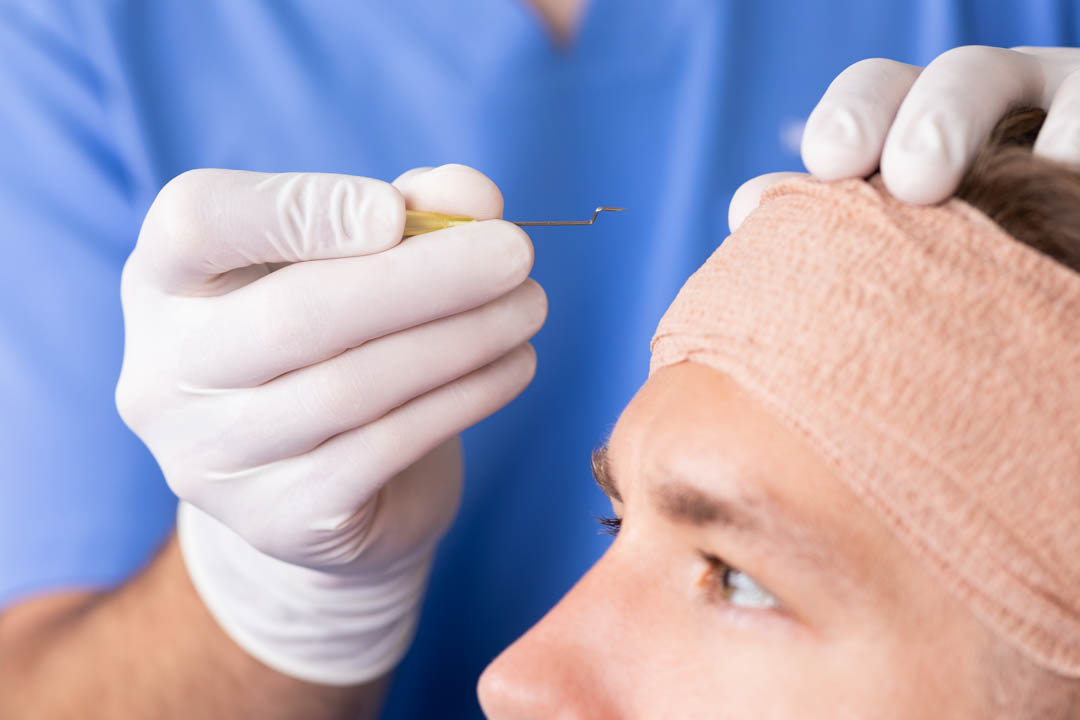
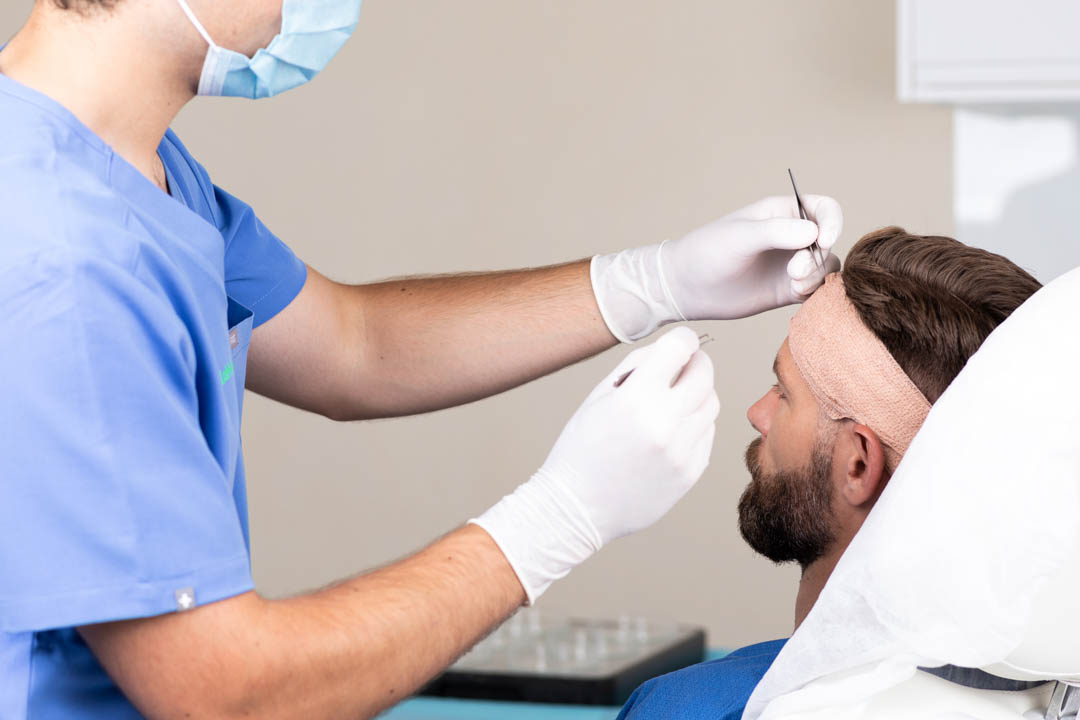
5. Follicle implantation
In the final step, the follicles are implanted one by one using implanters.
- The follicles go into the appropriate areas depending on how many hairs they contain – the goal is to achieve the most natural look.
- The follicles are implanted only with implanters, reducing the risk of damage and reducint graft out-of-body time.
Success!
Am I a good candidate?
If you are at least 25 years old and do not suffer from serious chronic diseases, you are most likely a good candidate for FUE hair transplantation.
Want to be sure?
Get a free, no-obligation consultation.
We’ll get back to you within 24 hours.
The administrator of the data is us, i.e. Michał Smyła NIP 6462963492 with registered office at al. Niepodległości 36, 43-100 Tychy, Poland. The data will be processed in order to respond to your inquiry in accordance with the regulations.
Or fill out the online consultation form:
Online consultation
Within 24 hours you will be contacted by a doctor and presented with treatment options.
Price list
Price list
FUE hair transplantation
popular
£1.50
£1.20 / graft
£1.20 / graft
promotion
For example:
Temporal recessions
£1500 - 2500
Crown
£1500 - 2500
Frontal area with hairline restoration
£2500 - 4000
BHT Hair Transplant (Body Hair Transplant).
£1.50 / graft
Beard transplant
£1.50 / graft
Consultation
free of charge
Price includes:
- Post-op care kit
- Meal and beverages
- Hotel stay
Frequently asked questions
Frequently asked questions
A hair transplant is a medical procedure in which so-called follicular units, i.e. naturally occurring groups of 1 to 4 hairs, are taken from genetically strong areas (the back and sides of the head – the donor area) and transferred to bald or balding areas: the front, top and top of the head (the recipient areas), where they grow permanently.
The cost of an FUE hair transplant at SmylaHair clinic is £1.50 per graft (current promotion – £1.20 / graft). A graft means a follicular unit, which can contain, on average 2-3 hairs.
For example:
- Small procedure (1000 grafts): £1190
- Medium-sized procedure (2500 grafts): £2990
- Large procedure (4000 grafts): £3990
FUE hair transplantation is an almost painless procedure – it is performed under local anesthesia from start to finish.
Some patients may experience minor pain after the anesthesia has worn off – but it is easily controlled with over-the-counter pain medications.
FUE hair transplantation leaves no linear scars.
The areas from which the follicles were taken are very small in diameter (0.7-0.9 mm) and become almost invisible after only about a week after the procedure.
Yes. The reults of FUE hair transplantation are permanent – the transplanted hair will not fall out.
If you are at least 25 years old and do not suffer from serious chronic diseases, you are most likely a good candidate for a hair transplant.
However, only a consultation with a doctor will give you complete certainty.
SmylaHair offers free, no-obligation online consultations – we will respond within 24 hours.
The two main methods of hair transplantation, which differ in how the follicles are harvested, are:
- FUE – Follicular Unit Extraction – a newer, minimally invasive method in which hair follicles are extracted one by one directly from the scalp (back and sides of the head). Using punches with a diameter of 0.7-0.9 mm, the surgeon makes incisions around the hair follicles, allowing them to be extracted. In their place, small holes are left, which heal a few days after the procedure, leaving almost no trace.
- FUT (STRIP) – Follicular Unit Transplantation – an older method in which the surgeon cuts an elongated flap of skin along with subcutaneous tissue at the back of the head with a scalpel. The flap is then precisely sectioned under a microscope into individual follicular units.
The follicular units, regardless of how they are harvested (FUE/FUT), are then implanted in the balding areas in the same manner.
Advantages of FUE hair transplantation:
- The treatment does not leave linear scars
- It is near-painless
- Short recovery period
- It is possible to take grafts from areas such as beard, chest
Disadvantages of FUE hair transplantation:
- The procedure takes longer than a FUT transplant (STRIP)
- It is more expensive than FUT (STRIP) transplantation
Depending on the extent of the procedure – FUE hair transplantation takes from 4 to 12 hours.
You can check the exact course of the entire procedure here.
The holes on the back of the head heal after 3-5 days after the procedure, the transplanted hair takes a little bit longer (up to 10 days).
Depending on the type of work you do, you may even be able to return to work the next day. However, most patients allocate 8-12 days for recovery.
A week after the procedure, you can return to moderate physical activity.
You can find the exact post-treatment instructions here.
A few days before the procedure, do not consume alcohol, smoke or take medications containing acetylsalicylic acid (Aspirin). Laboratory tests should also be performed.
You can find detailed instructions on how to prepare for the procedure here.
In the first few days after the procedure, the transplanted hair should be sprayed with the spray you will receive from us.
Avoid scratching them or prolonged exposure to the sun.
You can find detailed instructions for post-procedure management here.
Tips before and after the procedure
Before treatment
Research, which you must make at 10 days before treatment:
- Morphology
- Glycemia
- Coagulogram (APTT and INR)
- General urinalysis
- Serological tests :
- HIV (Combo)
- HBV ( HBs antigen )
- HCV (anti-HCVantibodies).
Email the results tous(info@smylahair.com) and bring them withyou to the treatment.
7 days before treatment:
- Do not take anymedicationcontainingacid acetylsalicylic (Aspirin) on 7 days before i 7 days at procedure.
Manyover-the-countermedicationsmaycontain acetylsalicylic acid, such as.
Aspirin, Etopyrin, Polopyrin, Acard, Polocard and others. - Do not take any lpainkillers/anti-inflammatory drugs for 7 days before the procedure, such as.
Ibuprom, Naproxen, Diclac.
Ifyou need totake a painkiller,you canuse paracetamol (Apap). - Do not takesupplements diet,including herbal, and B and E vitamins on the 7 days before i 7 days at procedure.
These substancescan increase bleeding and react with anesthetics.
For example, do not take: cod liver oil, melatonin, green tea, garlic extract. - Discontinue all forms ofuse oftobacco at 2 weeks before and 2 weeks after treatment (cigarettes, snuff, butalso preparations to helpquit smoking – such as patches, Niquitin gums).
Nicotine inanyformcansignificantly delay the healing process . - Cessationń drinking alcohol (wjointlyconnectąincluding beer and wine) at 48 hours before i 48 hours after surgery.
- Medications taken on aregularbasis: Takemedications as prescribed by your doctor (e.g.
medications for highblood pressure, asthma, finasteride).- If you are taking medications for arthritis (e.g., rheumatoid – RA), please let us know before the procedure for additional qualification.
- If you have diabetes,bring a glucometer withyou on the day of the procedure .
- If you have asthma,bringinhaled medication withyou on the day of the procedure.
- If you are using Loxon (minoxidil), cessation ofń its use on 2 days before surgery.
Mo żer returnć to use Loxone 7 days after treatment.
- Wash włosy In the morning on the day of treatment.
Blow-dry them and do notapply anyadditional products (e.g. gel, gum,conditioners).
On the day of surgery
The morning of the day of the procedure:
- Wash your hair.
Wysusz je i nie nakładaj żadnych dodatkowych produktów (np. żelu, gumy, odżywek). - Eat a normal breakfast.
- Wear comfortable clothes that go over your head easily (e.g., shirt, unbuttoned sweatshirt).
You can also bring loose headgear with you. - Take your test results and medications (if you are taking them permanently) with you.
After treatment
General guidelines
- The effects of medications used during the procedure may persist for 24 hours after the procedure.
Symptoms may include drowsiness, dizziness, confusion, nausea, redness/irritation of the skin head If you experience any of these symptoms, we recommend that you remain under adult supervision for 24 hours. - Drink plenty of fluids.
You can resume eating immediately after the procedure – there are no restrictions on diet. - Pain after the FUE procedure is rare, but take Ibuprofen 400 mg every 8 hours (after meals) in case of pain.
Be cautious if you have/had stomach disease, especially peptic ulcer disease.
You can also take paracetamol (Apap). - Do not drink alcohol for 48 hours after the procedure.
- Contact us if you experience the following symptoms:
- Pain that does not go away after taking the maximum dose of pain medication.
- Bleeding from the surgical site that does not stop after compression for 5 minutes
- Fever above 38.0 deg.
Celsius up to 7 days after surgery - Signs of surgical site infection, such as severe redness, swelling or pain, yellow/green exudate
- Body rash
- Nausea and vomiting that do not go away after taking antiemetics
- Call 112 if you experience swelling of the lips, tongue or throat that makes it difficult to breathe
The first night after the procedure
What to expect
- The scalp will be reddened
- On the back of the head (donor area) will be visible small This is normal, it will heal up to 3 days.
Hair and scalp care
- Do not wash your hair for more than 24 hours after
- Start spraying the transplanted hair with the aerosol you will receive from us – in the first day spray every 20 You can put a towel on the shoulders to drip excess liquid on it.
Food
- Have dinner.
There are no restrictions on - Do not drink alcohol for 48 after the procedure.
Dream
- Sleep with your head elevated – using two pillows.
An exudate may appear from the donor site (the back of the head), so we recommend that you place a dark towel over the pillows.
Day 1.
After the procedure
What to expect
- Redness of the scalp will fade, but may still persist.
- Scabs may appear, which will disappear by 10-14 days.
Hair and scalp care
- Do not touch, scratch or rub the transplanted hair, and avoid prolonged exposure to the sun.
- Spray the transplanted hair with a spray every 1-2 hours.
- You can wash your hair, but wait until the evening.
Wash your hair gently, using normal shampoo and low water pressure.
Dry your hair only by applying a towel, preferably a disposable one (don’t rub) and comb your hair only with your fingers (don’t use brushes, combs). - On the donor area (back of the head) you can apply a cream to promote wound healing, such as.
Cicatridine.
Physical activity
- Limit physical activity.
Dream
- Sleep with your head elevated on two pillows.
Day 2.-7.
After treatment
What to expect
- Redness/pigmentation of the scalp may persist for up to a week after the procedure.
- Two to three days after the procedure, puffiness may appear on the forehead and around the eyes.
Hair and scalp care
- The transplanted hair is already stronger, but continue to avoid touching, scratching, rubbing and prolonged exposure to the sun.
- W -3.
On the day, spray the transplanted hair with the spray every 1-2 hours – or until the liquid is exhausted. - Wash hair gently, dry only by applying a towel.
W 4.
Day you can start back using hair products other than shampoo.
You can use a brush and blow dryer, but be careful. - You can apply vitamin A ointment to the scabs at night.
- If swelling occurs, apply ice to the forehead and/or donor area (back of the head).
Do not put ice directly on the transplanted follicles (recipient area).
If swelling is severe, use medication as directed.
Physical activity
- You can return to light physical activities, such as gentle running, gentle strength training.
- Avoid the pool and sauna for 2 months after treatment.
Dream
- Sleep with your head elevated on two pillows.
Week 2.-4.
After surgery
What to expect
- You may begin to lose transplanted hair – this phenomenon is normal.
The loss may last up to 4-6 weeks.
This hair will grow back within 3-4 months. - Papules/pimples may appear in the recipient area.
They should disappear on their own, but you can use Microdacyn spray or antibiotic ointment (such as Tribiotic) on them.
Hair care
- You can return to normal hair washing.
If scabs persist, stay in the shower longer, use conditioner and massage the recipient area to remove the scabs. - You can go back to using Loxone and LLLT laser.
- After 10.
days after the treatment you can cut or dye your hair.
Physical activity
- You can return to full activity
Month 2.-3.
after surgery
What to expect
- Transplanted hair begins to grow.
During this period, existing hair may begin to fall out – this phenomenon is normal, these hairs will grow back. - During the period of intensive growth of transplanted hair, irritation of the recipient area may occur, which will disappear spontaneously after most of the transplanted hair grows out.
Hair and scalp care
- Avoid overexposure to the sun’s rays (use headgear or SPF filters).
6 months after surgery
What to expect
- The transplanted hair is getting thicker,
Hair and scalp care
- Avoid overexposure to the sun’s rays (use headgear or SPF filters).
12-18 months after surgery
You can see the final result of the hair transplant.
Congratulations!